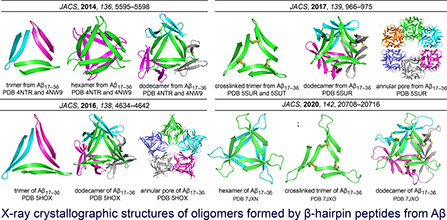THE NOWICK RESEARCH GROUP

Research in the Nowick group focuses on the chemistry and biology of peptides. Areas of particular interest include understanding molecular basis of amyloid diseases, such as Alzheimer’s disease, and the development of new antibiotics.
The design, synthesis, and study of new molecules is central to our efforts. We use small molecule chemical synthesis, peptide synthesis, and protein expression to create the molecules that we study, and molecular modeling, NMR spectroscopy, and X-ray crystallography to gain insights into their structures and biomolecular interactions. Experiments with mammalian cells and bacteria, as well as fluorescence microscopy help elucidate the biological properties of the molecules that we create, as do some animal-based studies in mice. A particular area of interesting our laboratory is the structures and supramolecular interactions of ß-sheets, which are central to the folding and assembly of the peptides associated with amyloid diseases, such as Alzheimer’s disease, as well as the antibiotic teixobactin.
.jpg?crc=398565796)
Our extensive program of research on understanding the molecular basis of amyloid diseases focuses on developing chemical models of the toxic amyloid oligomers associated Alzheimer’s disease and other amyloid diseases. In typical studies, we design peptides derived from Aß and other amyloidogenic peptides and proteins and then study their structures and assembly, as well as their biological properties. Through X-ray crystallography, we have been able to observe the structures of a variety oligomers formed by constrained ß-hairpin peptides derived from key amyloidogenic peptides and proteins. Current efforts seek to correlate these chemical models of amyloid oligomers with biogenic amyloid oligomers found in the brain and to develop antibodies and vaccines to block the neurodegeneration associated with these amyloid oligomers.

In 2015 we became interested in the newly reported antibiotic teixobactin and launched a program of study to learn more about its chemistry and biology. By synthesizing teixobactin analogues and studying their antibiotic activity, we gained new insights into the mechanism of action of teixobactin. Through X-ray crystallography, we discovered that teixobactin forms dimers and higher-order assemblies through ß-sheet formation that can bind to its molecular targets on the cell membrane of Gram-positive bacteria. We are now using what we have learned from teixobactin to design new antibiotics against MRSA, VRE, and other dangerous pathogens.

Students in the Nowick group partake fully of the rich environment of mentorship and training provided by our research laboratory. Graduate students participate in hypothesis generation, data collection, data analysis, and communication through oral and written presentation. Many graduate students choose to mentor undergraduate research students, further enhancing their graduate training while helping to train the next generation. I meet with students individually each week to discuss their results and plans for subsequent experiments. Additional scheduled and ad-hoc meetings occur throughout the week. When students are writing papers for publication, I work closely with them, providing guidance and feedback in the writing process.
My group and I meet collectively on Tuesday afternoons during our weekly group meetings. Our group meetings consist of three formats: research, literature, and workshop. In our research group meetings, students present and discuss their results orally with slides and get feedback and discussion that leads to ideas for future experiments. In our literature group meetings, we discuss important publications from the current literature, with each student making slide presentations on articles. When students are preparing to give talks or engaging in various writing projects, the group often provides feedback and guidance in a workshop format. Through this program of research training, continuing education, and mentorship, students acquire the skills to become successful independent scientists.
Group members are encouraged to partake of the rich educational and networking opportunities provided by attending and presenting at scientific meetings. The annual Peptide Therapeutics Symposium in San Diego provides great opportunities to present and network with scientists from the nearby pharmaceutical and biotechnology industries in San Diego. The biennial Chemistry and Biology of Peptides Gordon Research Conference in Ventura is also superb. Other popular meetings include the biennial American Peptide Symposium, the biennial National Organic Symposium, and the biannual meetings of the American Chemical Society. For group members who present, I try to help cover part of the costs of attending these and other scientific meetings.
Ph.D. graduates from the Nowick group go on to careers in the pharmaceutical and biotechnology industries and academia, as well as non-traditional pathways. Positions of Nowick group alumni include careers at Roche, GSK, Encodia, and other leading companies, as well as faculty positions at NYU, the University of South Carolina, and Orange Coast College. I am happy to provide Ph.D. graduates continued mentorship and networking opportunities throughout their careers, and I encourage group alumni to check in periodically by e-mail, phone, Zoom, or in person.